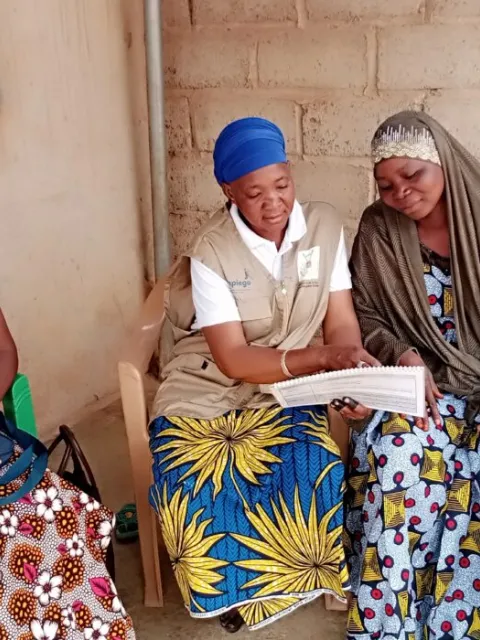Streamlining women's health in low-resource settings: the promise and pitfalls of integrating breast and cervical cancer screening

UICC Young Leader, Dr Lily Gutnik, draws on her experience in Sub-Saharan Africa to highlight how combining cervical and breast cancer screenings can enhance accessibility and efficiency, but also emphasises the complexities of implementation, including workforce training, different screening guidelines, and maintaining high standards of care.
Ten years ago, when I started my professional journey in breast cancer in Sub-Saharan Africa, I conducted a research study on a health service integrated approach to breast cancer screening.
The initiative involved training lay women to conduct screening clinical breast exams (CBE) for women who were already coming to an outpatient clinic at a large tertiary public hospital for other reasons: to see their general practitioner, for antenatal care, or to access cervical cancer services.
We found that this approach was feasible, meaning that laywomen can be successfully trained to conduct these exams with comparable outcome to physicians. We also found that it was acceptable in the sense that Malawian women were willing to participate in this type of screening initiative in this setting.
Indeed, as part of the study, we conducted semi-structed interviews with the women who participated in this screening to better understand their experience with this initiative and their ideas for establishing a national screening programme. To our surprise, almost 20% of the women asked why we didn’t also perform a cervical cancer screening exam.
As a specialist in breast surgical oncology trained and based in the US, I never thought until this study of the idea of integrating different cancer screening, though this is in fact the basis of a people-centred approach to women’s health.
Several years later, I connected with an outstanding large health system in Cameroon, which runs the largest cervical cancer screening programme in the country. It is delivered by incredibly talented and devoted nurses, who perform VIA screen and treat or HPV testing depending on guidelines recommendations and the preferences of each patient
The design and structure of this screening programme was targeted from its inception for cervical cancer, but they soon added a breast cancer screening component. Every woman that undergoes a mode of cervical cancer screening also gets a screening clinical breast exam.
The programme has now been running for 15 years and expanding sites throughout the country. My team and I are currently conducting a multi-level programme evaluation of this integrated approach.
Based on the data we have collected, we have identified a number of challenges and opportunities of this approach.
Health System Complexity
Breast and cervical cancer screenings require distinct tools and expertise. If a cervical cancer screening programme already exists, then adding a CBE for the patient is feasible in settings where the workforce doing the cervical cancer screening can be trained on how to conduct a proper CBE. Numerous studies have even shown that this can be done by a trained layperson or community health worker and not necessary a clinician.
However, if there is an existing breast cancer screening programme, layering on a cervical cancer screening component may be more challenging with more dedicated training and time needed to adequately perform a VIA screen and treat or provider collecting HPV samples. If the cervical cancer screening method is HPV self-collect by the patient, then it would depend on where and when this self-collection is being done, and if there is any interaction if any form of health worker.
Regardless of the screening approach, it is critical that a referral system is in place and that those receiving facilities have the diagnostics and treatment capacity to take care of any cancer that is detected. Thus, in an integrated screening approach, there must be capacity for both breast and cervical cancer diagnosis and treatment – this is not something all health systems are able to offer.
Workforce and Infrastructure
Though there can be training, education, and even task shifting with various methods of breast and cervical cancer screening, there still remains the question of time and space. Does the provider doing screening have time to do both screenings with high quality and skill? Are they also expected to perform many other duties? Is there enough space (if in clinic setting) to accommodate the necessary tools and staff, including waiting area?
Though mobile clinic solutions sound appealing and certainly help with improving access, they can be very burdensome for the staff. Some early insights from my current work in Cameroon show that the nurses have a strong preference to work in their brick-and-mortar clinics where all the necessary tools are readily available, and privacy is not an issue.
Of course, in health systems that have well maintained and reliable clinic infrastructure, with a workforce who can handle additional patients and tasks, the integrative approach is an ideal set up. It is an opportunity to leverage an existing infrastructure to broaden its scope of practice while maintaining a workforce that is not overwhelmed. For example, cervical cancer prevention has successfully been incorporated into HIV services in various regions.
Guideline-concordant care
Guideline-concordant care means providing medical treatment that follows established best-practice guidelines based on research and expert recommendations. A significant challenge in the integration of breast and cervical cancer screening is the different recommendations of age and frequency of screening.
Depending on country and professional society, recommendations for breast cancer screening start anywhere from 40-50 years old and end at age 74 or when there is less than a 10-year life expectancy. Similarly, screening interval can be annual or biannual.
Cervical cancer screening is often recommended to start at around age 25 and end around age 64, with repeat screening every three to five years depending on prior test results, method of screening, and other risk factors.
These wide discrepancies make a cohesive integration very challenging. Furthermore, there is limited global and national guidance on how to effectively integrate these services into existing health structures, which complicates adoption.
Efficiency in Service Delivery
Combining screenings for breast and cervical cancer during the same visit can save the patient time and resources, making preventive care more accessible to women. Based on insights from Malawi and Cameroon, patients really favour this integrative approach. They feel it saves them time by avoiding multiple visits, often at different locations, and reduces indirect costs such as transportation and a loss of income from not working when seeking health care.
The integrated approach also helps women feel empowered and embrace preventative care – a concept that is still new for many populations in low-resource settings where clinics and hospitals are seen a place to go when someone is sick, not to prevent getting sick. Thus, these opportunities for health promotion and prevention may also have further positive spillover effects by improving uptake in other preventative health services.
Integrated breast and cervical cancer screening can lead to more comprehensive and gender-responsive care, building stronger health systems that are better equipped to meet women’s diverse health needs. By addressing these challenges, integration offers an opportunity to advance early detection, improve patient outcomes, and optimise the use of healthcare resources. However, more thought and consideration needs to be given for how to best operationalise the integrative approach to screening.
Last update
Monday 28 October 2024Share this page


